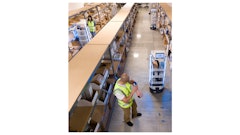
Amid global disruption caused by the Coronavirus disease (COVID-19) pandemic, every industry must take a hard look at where it has felt the most significant impact and then work to remediate its effects.
It is easier said than done, of course.
When addressing the pandemic, the biggest problem with forecasting impact and determining potential solutions is that no one can predict what the world will look like even a few months from now. The limited visibility into the future makes it difficult to determine the outlook for many industries.
The supply chain segment, a segment nearly everyone across the globe relies upon in some way, shape or form, has not been immune to the effects of COVID-19. For example, the unexpected closure of a single shipping facility due to a COVID-19 outbreak could disrupt and have lasting impact through the rest of the supply chain. The supply chain, no matter how robust it may seem, is suddenly more fragile in the face of a global pandemic.
To best prepare for the “uncertain” requires a commitment to three, different strategies within the supply chain—digital transformation, adaptability and hyper-localization. All three enable supply chain executives to strengthen their supply chains, so that they are bullet-proof when unexpected disruptions occur. The pandemic is the most recent and most severe example of a supply chain disruption, but there are other unpredictable scenarios that could occur in the future, like natural disasters, that could easily have negative impact on the supply chain as well if an organization is not prepared for it.
Digital transformation
When it comes to the last mile of the supply chain, it is very important to deliver an excellent customer experience, despite what outside events may be impacting the supply chain. While certain impacts may be inevitable, like a facility closure or a slightly depleted fleet if an outbreak occurs, the application of digital transformation to help streamline supply chain processes, especially in the last mile, will soften much of that immediate impact.
Through technology innovations, finding ways to uncover new efficiencies and doing more with less is paramount when dealing with uncertain realities. Powerful digital tools in delivery orchestration technology can lead to improved supply chain operations as well as improved customer experiences, two areas that tend to lag amid any kind of a disruption.
Delivery orchestration technology can automate many logistics processes, which can speed up the entire delivery cycle. It can help fleet drivers complete their work more quickly, give end-to-end visibility into product inventory tracking and delivery, and provide more accuracy with delivery windows by accounting for a multitude of delivery factors (driver, time on site, etc.). Technology powers faster and better deliveries – leveraging it during a time of disruption, when delivery speed and service may already be impacted, helps organizations to better navigate those disruptions and ultimately bounce back from them stronger.
Apart from efficiency, technology also helps to save organizations money, reducing operational costs. Through intelligent dispatch and batching, technology can improve resource utilization as well as intelligently optimize the best routes for delivery fulfillment, both of which dramatically cut down on cost expenditures.
Adaptability
Supply chain leaders can never underestimate the value in being able to adjust to the New Normal. When disruptions occur, the answer for many organizations is to return to the status quo, operating in the exact same way as they did prior to the disruption. However, from a long-term perspective, that may not always be in an organization’s best interest. Refusing to adapt to new realities may just be putting off the inevitable.
What is harder to do is to change with the times. Being agile and adapting to new market realities helps put organizations in a better position against their competition.
A great example of where agility is important is in the grocery segment. The grocery supply chain has typically been reliant on third-party marketplaces for consumer delivery, and the global pandemic certainly shed light on this model. However, many grocery stores are now beginning to pivot to offer curbside pickup. Curbside is more profitable than leveraging third-party marketplaces, and it meets the needs of consumers who want their groceries faster but who may not want to go into an actual store. Instead of waiting at home for a designated delivery time, consumers can order for curbside pickup and collect their goods almost immediately. Organizations that can quickly adapt to consumer needs, trends and new realities (like the demand for curbside pickup) will ultimately capture a larger market share of new digital customers.
Technology also comes into play here as it can help expedite those types of delivery pivot decisions, sending out immediate alerts to shippers and fleets to prioritize a new type of delivery.
Hyper-localization
Companies must optimize what is available locally to them to best strengthen their supply chains. This allows them to continue to route resources and inventory to complete delivery fulfillments amid major supply chain interruptions. For a large retailer, if one of their shipping centers has a virus outbreak, it will negatively impact or momentarily halt deliveries coming out of the center. Having more hyper-local options, even using the retailer’s own stores or local vendors to build a hyper-local network, not only helps to scale the business but also helps the business to curtail the results of unexpected downtime at facilities.
Ultimately, leveraging all three approaches is important to build supply chain resiliency. All these strategies contribute to a stronger, unbreakable supply chain that can weather any storm. It’s not always possible to avoid disruptions, especially disruptions brought on by COVID-19, but there are approaches to take that can help supply chain executives better prepare for them.


























